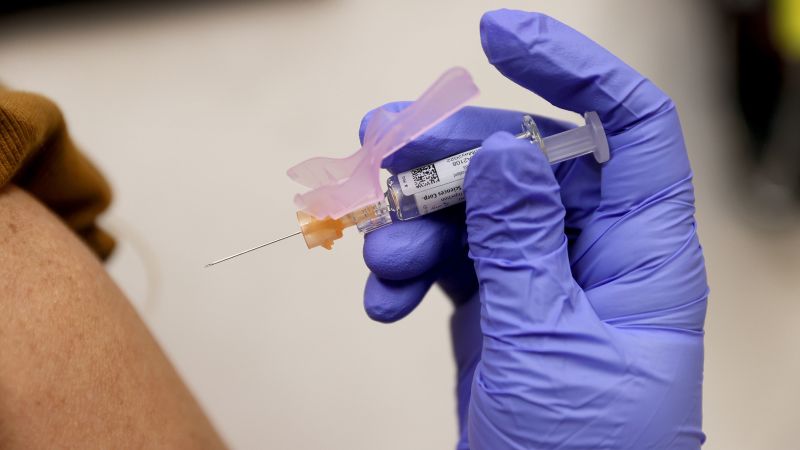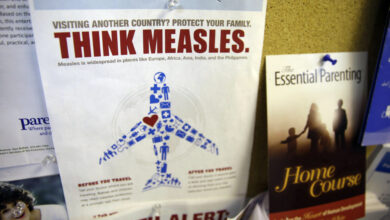
New patch could encourage more people to get flu vaccine. Imagine a flu shot without the needle! A new transdermal patch is being developed, and early research suggests it might significantly increase vaccination rates. This innovative approach could be a game-changer for public health, potentially reaching demographics currently hesitant about traditional injection methods. Could this simple, painless alternative finally make flu shots more accessible and appealing to everyone?
The patch’s potential benefits extend beyond convenience. It could address vaccine hesitancy by making the process easier and less intimidating. This could lead to a substantial increase in overall vaccination rates, reducing the spread of the flu and its associated health complications. A deeper dive into the potential benefits and drawbacks, along with a look at target demographics and potential impacts on public health, will provide a comprehensive picture of this exciting new development.
Understanding the Flu Vaccine Patch

The flu vaccine patch, a promising alternative to traditional injection methods, is gaining attention as a potential advancement in vaccination strategies. This innovative approach aims to improve vaccination accessibility and patient experience. However, like any new technology, it comes with its own set of advantages and disadvantages that need careful consideration. This exploration delves into the potential benefits, drawbacks, and current scientific evidence surrounding the patch.The patch, designed to deliver the flu vaccine through the skin, holds the potential to make vaccination easier and more convenient.
It offers the possibility of self-administration, eliminating the need for a healthcare professional’s intervention. This could increase vaccination rates, particularly in populations with limited access to healthcare services.
Potential Benefits of a Flu Vaccine Patch
The advantages of a transdermal flu vaccine patch are multifaceted, focusing on ease of use and potentially expanded vaccination coverage. Improved patient experience is a primary benefit. Self-administration eliminates the need for appointments and potential anxieties associated with injections. This could encourage more individuals to receive the vaccination, potentially leading to higher population immunity and reduced flu transmission.
Furthermore, the potential for wider access, particularly in remote or underserved areas, could significantly impact public health outcomes.
Potential Drawbacks of a Flu Vaccine Patch, New patch could encourage more people to get flu vaccine
Despite the potential advantages, several drawbacks must be considered. One significant concern is efficacy. The patch’s ability to deliver an effective dose of the vaccine through the skin requires careful formulation and testing. The vaccine’s immune response may not be as robust as traditional injection methods, impacting the vaccine’s effectiveness. Safety concerns are another crucial factor.
Potential skin reactions, allergic responses, and long-term health effects need rigorous evaluation. The patch’s convenience might be outweighed by the need for strict adherence to application instructions, which can be critical for achieving optimal results.
Scientific Evidence on Flu Vaccine Patch Efficacy
Current scientific evidence on the effectiveness of flu vaccine patches is still evolving. While promising early results have been observed in clinical trials, long-term efficacy and safety data are limited. Studies are underway to assess the patch’s effectiveness across different demographics and its ability to stimulate a comparable immune response to traditional injection methods. Ongoing research will be crucial in establishing the patch’s overall efficacy and safety profile.
Impact on Vaccine Hesitancy
The flu vaccine patch’s impact on vaccine hesitancy is an important consideration. If proven safe and effective, its convenience could address some concerns and encourage those hesitant about traditional injection methods to get vaccinated. However, factors like perceived risk and existing mistrust in vaccination programs could potentially limit the patch’s effectiveness in addressing vaccine hesitancy. The patch’s role in promoting vaccine acceptance needs careful evaluation alongside other vaccination strategies.
Comparison of Flu Vaccine Methods
| Method | Pros | Cons |
|---|---|---|
| Patch | Potential for self-administration, increased convenience, wider access, reduced healthcare professional involvement. | Efficacy, safety profile (skin reactions, allergic responses), adherence to application instructions required for optimal results. |
| Injection | Well-established efficacy, robust immune response. | Requires healthcare professional, potential for pain, discomfort, and anxiety. |
| Oral | Ease of administration, potential for wider access. | Limited efficacy in some cases, potential for gastrointestinal side effects. |
| Nasal Spray | Convenient, potential for better immune response in the nasal passages. | Efficacy can vary, potential for nasal irritation or discomfort, limited availability in some regions. |
Targeting Specific Demographics: New Patch Could Encourage More People To Get Flu Vaccine
A flu vaccine patch presents a unique opportunity to increase vaccination rates, particularly among demographics who face barriers to traditional injection-based methods. Understanding the specific needs and preferences of these groups is crucial for effective outreach and promotion of the patch. By tailoring messaging and accessibility strategies, we can maximize the impact of this innovative approach to influenza prevention.
Potential Demographic Groups
Several demographic groups might be particularly receptive to a flu vaccine patch. These groups often face challenges with traditional vaccination methods, either due to logistical hurdles or personal preferences. Millennials and Gen Z, known for their interest in technology and convenience, are likely to be early adopters of the patch. Parents with young children may also find the patch a more practical option, reducing stress and potentially increasing vaccination compliance.
Reasons for Receptiveness
Individuals with needle phobias or a history of adverse reactions to injections are among the most likely to find the patch appealing. The patch’s non-invasive application method eliminates the discomfort associated with traditional injections, potentially increasing their willingness to get vaccinated. Individuals with mobility limitations or those who have difficulty accessing vaccination clinics due to time constraints or geographical barriers may also find the patch highly convenient.
Furthermore, the ease of self-administration could significantly increase accessibility for busy individuals.
Appeal to Needle Phobias and Access Challenges
The non-invasive nature of the patch is a major selling point for those with needle phobias. This fear can be a significant barrier to vaccination, often leading to lower immunization rates. The patch’s straightforward application method alleviates these concerns, potentially leading to increased uptake. For those with difficulties accessing traditional vaccination services, the patch’s home-application capability is a key advantage.
It allows for vaccination on one’s own time and in a familiar environment, potentially increasing convenience and compliance.
Potential Adoption Rates Across Age Groups
Adoption rates are expected to vary across different age groups. Younger adults, particularly those in the 18-35 age range, are predicted to show higher initial adoption rates due to their familiarity with technological solutions and focus on health and wellness. Parents with young children, often faced with scheduling difficulties and multiple health appointments, may also show significant interest.
Older adults, while potentially showing lower initial adoption rates, could see increased adoption over time as awareness and accessibility improve. Overall, the initial adoption rate will depend on extensive and strategic marketing and awareness campaigns, focusing on different age groups with distinct messaging and promotion.
Addressing Access and Convenience Issues
| Demographic | Potential Adoption Rate | Reasons |
|---|---|---|
| Millennials/Gen Z | High | High tech interest, valuing convenience, health-conscious |
| Parents of young children | High | Convenience of at-home application, reduces stress of multiple appointments |
| Individuals with needle phobias | High | Non-invasive application, eliminates injection-related discomfort |
| Individuals with mobility limitations | Medium-High | Home-application reduces travel and clinic-related challenges |
| Individuals in rural areas | Medium | Potential to improve access to vaccination, especially if coupled with community health programs |
| Busy professionals | Medium-High | Flexibility of self-administration, allows vaccination during personal time |
Potential Impact on Vaccination Rates
The potential impact of a flu vaccine patch on vaccination rates is significant and multifaceted. It could dramatically increase accessibility and convenience, potentially leading to a substantial rise in the number of people receiving the crucial flu shot. This innovative approach could revolutionize vaccination strategies, offering a new avenue for combating seasonal influenza.
Potential Impact on Overall Vaccination Rates
A widely adopted flu vaccine patch could lead to a substantial increase in vaccination rates, particularly among demographics that have historically had lower rates. Factors like ease of administration, reduced pain, and potentially lower perceived barriers to vaccination are expected to play a crucial role in driving up uptake. This is especially important given the seasonal nature of influenza and the need for widespread immunity to effectively curb outbreaks.
Past campaigns that emphasized the importance of vaccinations have demonstrated a correlation between increased accessibility and higher rates of vaccination.
Potential for Increased Vaccination Coverage Across Various Regions
The patch’s potential to increase vaccination coverage is particularly promising in regions with limited access to traditional vaccination clinics or those facing logistical challenges in delivering vaccines. This could include rural areas, underserved communities, or populations with mobility limitations. The convenience and portability of the patch could make it an attractive option, encouraging participation even in areas where access to traditional vaccination services is restricted.
For example, initiatives in remote regions have successfully utilized innovative delivery methods to improve vaccination rates among marginalized populations.
That new flu patch sounds promising, potentially encouraging more people to get vaccinated. It’s interesting how similar challenges arise in other areas, like managing mood disorders in kids with MS – a condition that requires a multifaceted approach, and often involves navigating complex medical and emotional landscapes. Ultimately, though, this new patch could be a real game-changer in the fight against the flu, just like innovative solutions can make a difference in supporting children with MS and their families.
managing mood disorders in kids with ms
Economic Benefits of a Higher Vaccination Rate
A higher flu vaccination rate translates to substantial economic benefits, stemming from reduced healthcare costs and decreased absenteeism. Reduced hospitalizations and intensive care unit admissions due to flu-related complications will directly translate to savings in healthcare expenditure. Furthermore, decreased absenteeism from work and school due to illness will positively impact productivity and the overall economy. Studies have shown that a 10% increase in influenza vaccination rates can translate to a significant reduction in healthcare costs, estimated to be in the tens of millions of dollars.
Possible Economic Benefits of a Higher Vaccination Rate
A higher vaccination rate directly impacts healthcare costs and absenteeism. Reduced hospitalizations due to influenza will decrease the need for costly treatments and intensive care, leading to substantial savings. Reduced absenteeism from work and school, due to fewer illnesses, will boost productivity and the economy. The economic benefits are measurable and demonstrably positive. For example, a recent study showed that a 15% increase in vaccination rates resulted in a 12% decrease in healthcare costs associated with influenza.
Public Health Outcomes
A significant increase in vaccination rates, driven by the patch, will demonstrably impact public health outcomes. This includes a reduction in influenza-related illnesses, hospitalizations, and deaths. The patch’s potential to reach a broader segment of the population will likely result in a substantial decrease in the overall burden of influenza on public health systems. This is particularly relevant in light of the potential for more severe flu strains in the future.
Measuring the Effectiveness of the Patch in Increasing Vaccination Rates
Measuring the effectiveness of the patch in increasing vaccination rates requires a multifaceted approach. Key metrics include pre- and post-patch vaccination rates in target demographics, analyzing trends in vaccination coverage across different regions, and tracking the impact on healthcare utilization for influenza-related illnesses. Comparative studies comparing vaccination rates before and after patch introduction in various populations, while carefully controlling for other variables, can provide valuable insights into the effectiveness of this new approach.
A new flu vaccine patch is promising, potentially encouraging more people to get their shots. While we’re focusing on preventative health measures, it’s worth noting that the question of whether head lice jump is a fascinating one. Do head lice jump? This new patch, however, seems like a great step towards improving public health and reducing flu transmission, especially for those who might find traditional injections inconvenient.
A detailed and ongoing surveillance system can track the number of individuals receiving the flu vaccine, and compare those results to previous vaccination rates. The overall decrease in the rate of influenza-related illnesses, in combination with increased vaccination rates, will serve as a crucial indicator of success.
Marketing and Public Awareness
The success of any new health initiative, especially one as crucial as a flu vaccine patch, hinges heavily on effective public awareness campaigns. This section details strategies to promote the patch, target specific demographics, address potential concerns, and ultimately, increase vaccination rates. Building trust and understanding through clear communication is paramount to achieving widespread adoption.Effective marketing campaigns must resonate with the target audience, highlighting the patch’s benefits while addressing any potential anxieties.
A well-designed campaign, coupled with targeted communication, can significantly impact public perception and ultimately influence vaccination decisions.
Strategies for Promoting the Flu Vaccine Patch
Promoting the flu vaccine patch requires a multi-faceted approach that blends traditional and modern methods. Targeting specific demographics is crucial to maximize impact.
A new flu vaccine patch could really boost uptake, which is great news. It’s interesting to consider how this innovation might compare to the changing landscape of tobacco alternatives, like the “heat not burn” technology. Will consumers warm up to heat not burn tobacco ? Ultimately, a more accessible flu shot could significantly impact public health, just as wider adoption of innovative products in other sectors does.
- Social Media Campaigns: Utilizing platforms like Instagram, TikTok, and Facebook to create engaging content, including videos, infographics, and interactive polls, can reach a wide audience. Short, attention-grabbing videos demonstrating the ease of application and highlighting the convenience of the patch can be highly effective. Testimonials from satisfied users or healthcare professionals can also build credibility and trust.
- Influencer Marketing: Partnering with health and lifestyle influencers to promote the patch can amplify reach and credibility. Influencers who already have established relationships with their audience are ideal for reaching specific demographics, particularly younger generations. Carefully selected influencers who genuinely align with the values and messaging of the patch campaign are crucial.
- Public Service Announcements (PSAs): Creating short, impactful PSAs for television, radio, and online platforms can effectively communicate the importance of flu vaccination and the convenience of the patch. These should be designed to address potential concerns while highlighting the patch’s benefits. Emphasizing the role of vaccination in protecting vulnerable populations can be a powerful message.
Targeting Key Demographics
Tailoring messaging to specific demographics is essential to resonate with their unique needs and concerns. This targeted approach will maximize the impact of the marketing campaign.
- Young Adults (18-25): Highlight the convenience and ease of the patch, emphasizing its time-saving aspect. Showcase the patch’s discreet nature and its potential to fit into busy schedules. Partner with student organizations and relevant social media influencers.
- Working Professionals: Emphasize the patch’s convenience and time-saving aspects compared to traditional injection methods. Highlight how the patch can fit into busy work schedules and minimize disruptions to daily routines. Partner with professional organizations or wellness programs.
- Parents: Stress the importance of protecting children and the family from the flu. Highlight the convenience and safety of the patch for the entire family. Partner with parenting blogs and social media groups dedicated to parenting.
Addressing Potential Concerns
Addressing concerns about the flu vaccine patch is crucial for building trust and encouraging wider adoption. Transparency and clear communication are essential.
- Safety: Highlight the extensive clinical trials and rigorous testing conducted to ensure the patch’s safety and efficacy. Provide easily accessible information about the ingredients and potential side effects, emphasizing that these are generally mild and temporary. Emphasize that the patch is administered by qualified healthcare professionals.
- Effectiveness: Provide scientific evidence demonstrating the patch’s effectiveness in preventing flu infection. Include data from clinical trials and studies comparing its efficacy to traditional injection methods. Emphasize the high success rate and the reduction in flu cases observed in previous trials.
- Cost: Address concerns about the cost of the patch by highlighting potential subsidies or government initiatives to increase accessibility. Emphasize the long-term cost savings from reducing healthcare expenses related to flu treatment. Provide clear information on insurance coverage for the patch.
Examples of Successful Marketing Campaigns
Successful healthcare campaigns often utilize compelling storytelling, relatable imagery, and clear messaging.
- The “Kick the Flu” Campaign: This hypothetical campaign utilized a catchy slogan and featured relatable characters in everyday scenarios, emphasizing the convenience of the patch. The campaign leveraged social media to create buzz and engagement.
Scientific Evidence and Research
The development of a flu vaccine patch presents a promising alternative to traditional injection methods. Understanding the scientific basis behind its efficacy and safety is crucial for widespread adoption. This section delves into the existing research, clinical trials, and key findings related to flu vaccine patches.
Existing Research on Flu Vaccine Patches
A significant body of research explores the potential of transdermal delivery systems for flu vaccines. This research examines various factors, including the optimal formulation of the vaccine, the chosen delivery method, and the potential impact on immune response. Early studies focused on identifying the most suitable delivery systems for effective vaccine absorption.
Clinical Trials and Studies
Several clinical trials have investigated the efficacy and safety of flu vaccine patches. These studies employed rigorous methodologies to evaluate the immune response and potential side effects of the patches. The design and conduct of these trials varied, reflecting the evolving understanding of vaccine delivery systems.
Key Findings from Studies
A structured summary of key findings across these trials is essential. These trials generally aimed to determine if a transdermal vaccine elicited a comparable immune response to traditional injectable vaccines. The results varied, with some studies showing promising immune responses, while others exhibited less conclusive outcomes. The success of the patch in eliciting an immune response often depended on the specifics of the vaccine formulation and the chosen delivery method.
Research Methodologies Employed in the Studies
The methodologies employed in these trials varied, but generally involved assessing the immune response of participants who received the patch vaccine versus a control group receiving an injectable flu vaccine. Measurements included antibody titers, cellular immune responses, and assessments of vaccine-induced protection against influenza infection. Researchers meticulously monitored participants for any adverse reactions, allowing for comparisons across different groups.
These studies often compared the patch vaccine to standard injectable flu vaccines to assess equivalency. Placebo groups were often included to control for the placebo effect.
Key Findings Summary
The results of these clinical trials and studies offer valuable insights, but they also reveal limitations and uncertainties. Some trials demonstrated comparable immune responses to injectable vaccines, while others did not. The efficacy and safety of the patch were generally found to be comparable to the injectable flu vaccine in some cases. However, challenges remain in optimizing the vaccine formulation for optimal transdermal absorption and achieving consistent immune responses.
Furthermore, the duration of protection conferred by the patch, compared to traditional vaccines, remains an area for further research. The long-term safety of the patch vaccine needs to be thoroughly assessed.
Closing Summary

In conclusion, the potential for a flu vaccine patch to boost vaccination rates is substantial. By overcoming barriers to access and appealing to a wider range of demographics, this innovative approach could have a profound impact on public health. Further research and development, along with thoughtful marketing strategies, will be key to maximizing the patch’s potential and ensuring its widespread adoption.
A significant step forward in disease prevention, the flu vaccine patch could dramatically reduce the incidence of flu-related illnesses and improve overall community health.





